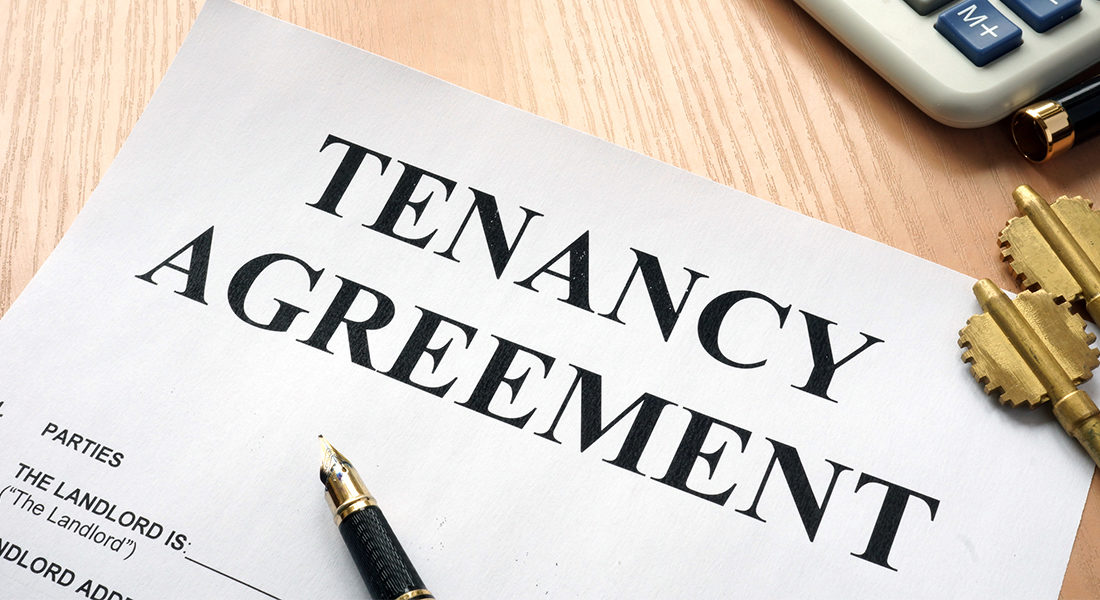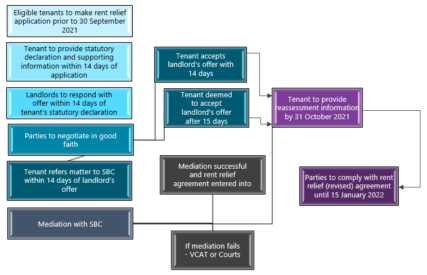Critical Aspects of the Victorian Commercial Tenancy Rent Relief

The Commercial Tenancy Relief Scheme Regulations 2021 (Vic) (New Scheme) providing for further commercial tenancy rent relief for Victorian tenants is now in operation.
Once again landlords and tenants are asked to share the burden where COVID-19 has adversely impacted tenants’ turnover through the provision of rent relief.
While the New Scheme has a similar base as previously, the latest regulations are significantly more prescriptive in relation to how and when rent relief must be sought, addressing some earlier failings.
The New Scheme applies from 28 July 2021 to 15 January 2022 (Protection Period), although a tenant’s eligibility for protection may vary during this period.
What hasn’t changed?
Large Format Retail participants will be familiar with the fundamental aspects of the rent relief scheme:
1. Eligible tenants must:
- have experienced a 30% decline in turnover during a relevant period;
- be SMEs – that is, being entities (or groups) with turnover less than $50m; and
- apply for rent relief providing prescribed supporting information.
2. Landlords must offer rent relief:
- proportional to the tenant’s decline in turnover;
- constituting at least 50% waiver of rent; and
- cannot recover instalments of deferred rent until after the end of the Protection Period.
3. Parties must act in good faith in relation to the implementation of the scheme.
4. In the absence of agreement, disputes may be referred to free mediation with the Small Business Commission (SBC), and failing resolution there, be dealt with in the Victorian Civil and Administrative Tribunal (VCAT) or the Supreme Court.
5. Extensive provisions permit binding orders by the SBC in the absence of good faith negotiation but are generally unlikely to be relevant.
What is different about the New Scheme?
Despite the similarities, there are many new requirements.
Eligibility
- Eligible Leases
The New Scheme applies to commercial leases entered prior to 28 July 2021 or renewed, varied, or extended after 28 July 2021 on substantially the same terms as a pre-28 July 2021 lease. Accordingly, leases entered after the commencement of the COVID-19 pandemic are covered.
- Tenant Eligibility
A tenant’s eligibility is now determined without reference to discontinued JobKeeper but using similar criteria as employed to assess JobKeeper entitlement. This includes complex rules regarding assessment of decline in turnover for businesses whose turnover may have been affected by matters other than COVID-19 – the most relevant to large format participants being due to restructuring or consolidating of businesses, establishment of new businesses, rapid growth, or irregular turnover.[1]
- Turnover
Turnover is defined as a tenant’s current GST turnover. Importantly, this includes online sales and Victorian government COVID-19 business support grants, but not federal government assistance.
Turnover is no longer linked to a particular premises as it was in the revised regulations passed in September 2020. Where a tenant has multiple premises, it is the impact on total turnover that is relevant. In other words, a more global view of a COVID-19’s impacts upon a tenant’s financial position is being taken.
Successful stores effectively subsidise unsuccessful ones.
- Relevant Period of Decline
Tenants are given some flexibility to nominate the relevant timeframe for assessment of decline in their turnover. Tenants whose businesses commenced trade pre-1 April 2019, can nominate any 3 consecutive months in the period April to September 2021 (inclusive) and compare turnover in that period to turnover in the same 3 months in (pre-COVID) 2019.
Different comparison periods apply for tenants who had not commenced trading pre-1 April 2019.[2]
Tenant Application and Landlord Response Process
- Tenant Application
Tenants seeking rent relief effective from 28 July 2021 must make their application for relief on or before 30 September 2021. If made after that date, any rent relief will only be applicable from the date the application is made.
To apply for rent relief, a tenant must make a request in writing providing information regarding the decline in turnover, including the relevant period, the turnover in that period and in the comparison period, the rent minimum rent relief required under the New Scheme and any other circumstances the tenant would like the landlord to consider.
The “other circumstances” gives context to the application and will likely be relevant in determining the reasonableness of the landlord’s response and should be carefully considered.
For example, while the decline in turnover is a whole of business assessment, if the tenant is especially impacted at a particular premises (or group of premises), there may be an argument that a higher proportion of waiver is appropriate in relation to the lease for that premises (or group).
- Tenant Statutory Declaration
The tenant must follow up the application with a statutory declaration made by an authorised officer of the tenant, accompanied by evidence of the tenant’s turnover figures, confirming eligibility, and the veracity of the turnover evidence.
The turnover evidence can be provided in the form of business activity statements, accounting record extracts, bank statements or statements by a practising accountant.
A rent relief application will lapse if the tenant fails to provide the turnover evidence and statutory declaration within a 14-day period, in which case a new application will need to be made. If a tenant allows its applications to lapse three times, the tenant will no longer be entitled to rent relief under the New Scheme.
- Landlord’s Offer
A landlord must respond to the tenant’s application within 14 days of receiving the tenant’s statutory declaration, with an offer for rent relief.
For a gross rent lease, the offer must be a proportion of gross rent. For other leases the landlord must consider waiving recovery of outgoings where is not able to operate their business at the premises.
- Acceptance or Dispute
A tenant must either accept a landlord’s valid offer within 14 days of receipt or refer the matter to the Small Business Commission for mediation.
A tenant’s failure to respond or refer will give rise to a deemed acceptance of the landlord’s offer.
Reassessment
Where rent relief was sought on or before 30 September 2021, the New Scheme provides for a mandatory reassessment of rent relief based using the tenant’s “change in turnover” between the September 2019 and 2021 quarters.
The tenant must submit by 31 October 2021 the relevant turnover figures and give a further statutory declaration confirming the tenant is an eligible tenant and the accuracy of the new turnover figures.
A failure to provide the required information by 31 October 2021 will mean the tenant will no longer be entitled to the waiver of rent from 31 October 2021.
Rent relief arrangements are then to be adjusted from 31 October 2021 to give effect to the difference between the proportions of the decline in turnover and the revised change in turnover, with the revised figure applicable until the end of the rent relief period (15 January 2022).
This obviates (and potentially prohibits) the need for monthly reassessment of turnover figures to determine relevant relief as was opted for by some parties under previous regulations, for a blunter but simpler two-phase rent relief assessment.
Accordingly, the New Scheme mandates two rent relief periods and decline calculations:
| Period | Rent Relief Proportion |
| 28 July 2021 to 31 October 2021 | Decline in three consecutive nominated months (April to September) in 2021 vs same months in 2019 |
| 1 November 2021 to 15 January 2022 | Decline in September quarter 2021 vs September quarter 2019 |
Protections Under the New Scheme
The New Scheme grants the following protections:
1. After Application, but prior to Rent Relief Agreement
Where a tenant makes an application for rent relief (which has not lapsed) and pays a proportion of rent reduced by the tenant’s decline in turnover, a tenant will not be in breach of obligations to pay rent and outgoings during the Protection Period.
This ability to withhold a proportion of rent (and seemingly all outgoing contributions) contrasts with the former regime, where tenants could effectively withhold all payments pending agreement as to rent relief.
2. Following Entry into Rent Relief Agreement
Once a landlord and tenant agree a rent relief agreement, a tenant will not be in breach of obligations to pay rent and outgoings provided the tenant complies with the rent relief agreement.
3. Protections Applicable in All Cases
The following protections apply to all eligible leases irrespective of whether a rent relief request has been made or agreed:
- Reduced Trading Hours: A landlord is not entitled to evict, re-enter the premises or have recourse to security where the tenant reduces trading hours or ceases to trade.
Tenants are effectively entitled to choose their own trading hours.
- Sickness or Natural Disaster: A tenant will not be in breach of obligations relating to the payment of rent and outgoings where the tenant is unable to trade as a result of:
- sickness or injury affecting the tenant, its officers, or employees; or
- a natural disaster affecting the tenant or the premises.
“Unable to trade” is a high bar, and sickness is unlikely to prevent a Large Format Retail tenant from trading unless it has impacted an entire (or significant part of a) team at a location.
It is unclear whether the COVID-19 pandemic constitutes a “natural disaster” for the purpose of this clause. Likely a prohibition on trade caused by COVID-19 restrictions would qualify. But this would need to relate to all the tenant’s stores and would also have to prevent click and collect and online sales.
- Rent Increases Forfeited: Rent increases scheduled under a lease are voided and cannot later be claimed by the landlord. This does not apply to increase based on turnover volume.
This would not seem to prevent a market rent review which results in a rent decrease.
The New Scheme includes a provision which effectively makes void any agreement which would allow a landlord to avoid the operation of the New Scheme.
False or Misleading Information
In addition to the general obligation of good faith, it is an offence for a party to give information or make a statement which it knows or suspects to be false. Where information may be misleading there is a positive obligation upon the party providing it to indicate where the information may be false or misleading and, if practicable, provide correct information.
Mediation and Determination
A landlord or tenant may refer a dispute regarding an eligible lease to the Small Business Commission (SBC) for mediation.
Given the short timeframes in which parties must resolve rent relief offers or refer the matter to the SBC, it can be anticipated that many matters will be listed for mediation and that waiting times for mediations will be long.
If the SBC issues a certificate that mediation has failed (or is unlikely to resolve) a dispute, either party may refer the matter for determination by VCAT (or the Supreme Court).
VCAT can consider a wide range of matters in determining appropriate rent relief in respect of any dispute, may make a broad range of orders to resolve the dispute.
Existing Rent Relief Agreements
Existing rent relief agreements (made under previous regulations) remain valid.
However, a tenant will be entitled to seek further rent relief to the extent that any existing arrangements are inferior to what the tenant might be entitled to under the New Scheme.
To the extent that an earlier rent relief agreement involved deferral of rent, any payments are further deferred until after 15 January 2022.
What if I am not an eligible tenant under an eligible lease?
Tenants who are not eligible tenants under eligible leases can still seek rent relief from their landlords, but will not be entitled to the protections and procedures contained in the New Scheme.
They can also refer any lease dispute to the Small Business Commission, who will provide free mediation services and will use the New Scheme as non-binding guidance.
In the spirit of cooperation, non-eligible tenants may wish to submit to their landlords requests for rent relief reflecting the requirements of the New Scheme, on the basis that it will be simpler for landlords to deal with requests in a consistent manner, and the scheme represents what is seen to be a fair and balanced solution.
In doing so, tenants should not misrepresent their eligibility but rather should be open and honest about eligibility and their need for relief.
Rent relief process

For further information regarding the operation of the New Scheme please visit:
- Birdsong Legal – https://www.birdsonglegal.com.au/
- Victorian Small Business Commission – https://www.vsbc.vic.gov.au/fact-sheets-and-resources/faqs/#commercial-tenancy-relief-scheme-2021-faqs
[1] Further discussion is beyond the scope of this article.
[2] On the assumption that this will not be applicable to most Large Format Retail tenants, this article does not go into detail regarding alternative methods for decline in turnover. However further information and explanations can be obtained if required by contacting Birdsong Legal.




